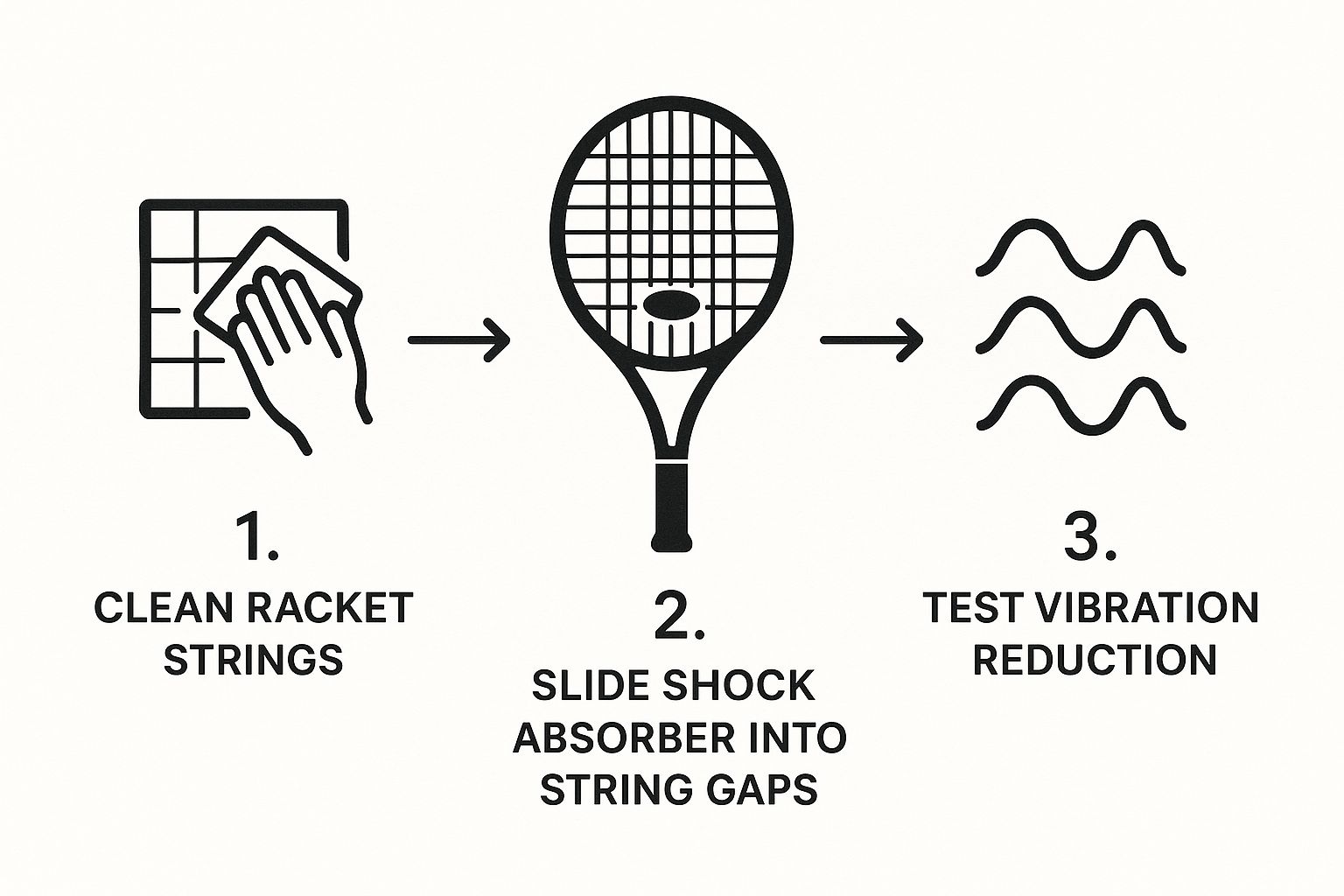
A tennis racket shock absorber—you might know it as a vibration dampener—is a small accessory that players fit onto their strings to change how the racket feels and sounds when they hit the ball. Here at Mantis, we find its main job is to turn that high-pitched 'ping' into a more solid, satisfying 'thud'. For more insights on customising your gear, our guide on how to choose a tennis racket is a great resource. While lots of players swear it prevents injury, the real benefit is about customising your racket's feel and sound.
What Does a Tennis Racket Shock Absorber Actually Do?
At Mantis, we know that the right gear can completely change your experience on the court, which is why we’re big on digging into every detail of your equipment. A great place to start is with the often-misunderstood tennis racket shock absorber. Understanding what this little accessory does—and more importantly, what it doesn't do—is your first step to getting your setup just right. If you want to dive deeper into your equipment, our guide on understanding tennis racket specifications is a great resource.
The main role of a shock absorber is to cut down the high-frequency vibrations that buzz through your strings on impact. This is what changes the sound from a sharp 'ping' to a lower-frequency 'thud', which many players find less distracting and more comfortable. It's a very personal thing; some players love the raw feedback from the strings, while others prefer the muted feel a dampener offers.
Let’s Bust a Common Myth
It’s time to clear up one of the biggest misconceptions in tennis: the idea that a shock absorber prevents tennis elbow or other arm injuries. It might feel like it's reducing all vibrations, but its effect is mostly on the sound, not the jarring impact forces.
Research from the University of Birmingham looked into this claim and found that dampeners don't significantly reduce the big, frame-rattling vibrations that travel up a player's arm. They mostly just change the noise, rather than providing the kind of mechanical dampening needed to prevent injury.
So, why do so many pros and club players use them? The benefits are all about comfort and personal preference. A shock absorber can:
- Improve Auditory Comfort: It mutes that high-pitched string sound for a duller, more solid noise.
- Enhance Feel: It creates a more dampened, solid sensation when you connect with the ball.
- Personalise Your Racket: It's a simple way to add a bit of personal style to your gear.
Ultimately, whether you use a shock absorber or not is a personal choice. It’s all about fine-tuning how your racket sounds and feels, helping you get the perfect connection to the ball.
Exploring Different Types of Shock Absorbers
Not all tennis racket shock absorbers are created equal, and the type you pop onto your strings can subtly change how your racket feels and sounds with every shot. At Mantis, we believe understanding these little differences is key to truly customising your gear. If you're just starting to explore ways to personalise your setup, our advice on how to choose a tennis racket is a great place to start.
There’s a surprising variety of designs out there, each with a specific job. Your final choice really boils down to a single question: how much feel do you want from the stringbed versus how much vibration do you want to kill?
Classic Button Dampeners
The most common style you’ll see is the 'button' dampener. These are those small, usually circular or square bits of silicone or rubber that fit snugly between two main strings right at the bottom of the racket.
Their main advantage is their minimalism. A button gives you just enough dampening to take the harsh edge off that metallic 'ping' without completely numbing the natural feel of the racket. This makes them a fantastic choice for players who want to stay connected to the ball but just want a slightly softer impact.
Worm or Snake Dampeners
For players who are after a more significant reduction in vibration, the 'worm' or 'snake' style is a popular go-to. These longer dampeners weave through multiple main strings, which increases their contact area and, in turn, their dampening power.
The result? A much more muted sound and a considerably dampened feel on impact. If you really can't stand any string vibration or that high-frequency 'ping', a worm dampener is an excellent way to go.
A key takeaway: The material and shape of a shock absorber directly influence its performance. The more strings a dampener touches and the denser its material, the more muted your racket will feel.
On the UK market, you'll mostly find button, worm, and fan-style dampeners. Silicone is by far the most popular material, prized for being both durable and effective. Button dampeners are typically favoured by players wanting to keep that raw racket feel, while worm and fan styles cover a bigger string area for more heavy-duty absorption. If you're keen to learn more about how these little gadgets have evolved over the years, you can find some great insights over on amBelievable.com.
How to Find the Right Dampener for Your Game
Picking a tennis racket shock absorber is a surprisingly personal decision. It all comes down to the sound and feel you want on the court. Here at Mantis, we think the choice should be practical, matching your gear to your game. It’s a lot like the process you go through when you how to choose a tennis racket in the first place—what matters most is what works for you.
To find your perfect match, start by thinking about how you play or ask your coach or a tennis professional. Are you an aggressive baseliner, generating huge power from the back of the court? Or are you a finesse player who relies on touch and delicate drop shots at the net? Each style really benefits from a different level of dampening.
Aligning Dampeners with Your Play Style
Power hitters often feel more comfortable with a substantial tennis racket shock absorber, like a worm-style model that covers several strings. That extra material creates a solid, muted feel on impact, which can make those big, powerful shots feel more controlled and less jarring.
On the other hand, touch players who need to feel the ball sink into the strings might find a large dampener too numbing. For them, a smaller button-style dampener is often the better fit. It successfully takes the harsh 'ping' out of the equation without sacrificing the crucial feedback needed for those precise shots.
Your personal sensitivity to vibration is the ultimate decider. A player who can’t stand any string buzz will lean towards maximum dampening, while another who enjoys that raw feedback might even choose to play without one.
Finally, don’t forget about aesthetics. Plenty of players use shock absorbers to add a bit of personality to their racket. With countless colours, shapes, and fun designs out there, your dampener can be a small reflection of your on-court style.
To make a smart choice, consider these key factors:
- Your Playing Style: Are you all about power or finesse?
- Vibration Sensitivity: Do you prefer a muted feel or raw, unfiltered feedback?
- Acoustic Preference: Do you want a solid 'thud' or a crisp 'ping'?
- On-Court Look: Does it match your personal style and gear?
By weighing these elements, you can find a shock absorber that not only feels right but also perfectly complements your entire on-court setup.
Getting Your Shock Absorber Installed Just Right
A shock absorber only does its job if it's installed correctly. More importantly, it needs to stay put when you’re trading blows in a tough rally. At Mantis, we want your gear to work flawlessly, so let's walk through how to fit the most common types of dampeners properly. Getting this right is just as crucial as following our advice on how to choose a tennis racket.
This visual guide shows the three simple steps to getting your dampener fitted securely, so it’s ready for action from your very first hit.

From prep to the final check, following this process ensures your dampener is secure and effective every time you step on the court.
But first, what are the rules? Official tennis regulations are clear: a dampener must be placed outside the area of the crossed strings. This means it can’t sit in the main part of your stringbed where you make contact with the ball.
Shock Absorber Placement and Legality
So, where exactly can you put it? The rules give you a few options, though most players stick to one spot for the best results. This table breaks it down.
| Placement Area | Is It Legal? | Reasoning |
|---|---|---|
| Below the bottom cross string | Yes | This is the most common and effective placement. It's outside the hitting area and dampens vibration well. |
| Above the top cross string | Yes | Legal, but far less common. It can feel a bit odd and may not be as effective for some players. |
| On the outer main strings | Yes | Technically allowed, as long as it's outside the crossed strings. However, it’s not very practical. |
| Anywhere within the crossed strings | No | This is illegal. Placing it here would directly alter the performance of the stringbed. |
The most popular and practical spot by far is at the bottom of the stringbed, just under the last cross string.
Installing Different Dampener Types
For a classic button dampener, the process is dead simple. Just slide it between the two centre main strings, right below that last cross string. Give it a firm, even push until you hear a satisfying 'pop'. That's how you know it's locked in.
A worm dampener needs a little more technique. Start at one of the centre main strings and begin weaving it over and under the adjacent mains. You want to create enough tension to hold it snug against the strings. If it’s too loose, it’ll fly off the first time you rip a forehand.
A dampener flying off mid-point is a classic sign of a poor fit. It either wasn't installed tightly enough, or it's stretched out over time and needs replacing. If it happens repeatedly, take it off and reinstall it with more tension, or just grab a new one.
To check your work, give the strings a quick tap with your hand. A properly installed shock absorber shouldn't rattle or slide around at all. Taking a moment to get this right means you can forget about it and focus on your game, enjoying a consistent feel with every shot.
Understanding Market and Player Trends
That little piece of rubber or silicone on your strings? It's much more than just a simple accessory. Tennis racket shock absorbers sit at the centre of a booming market, one that’s constantly being shaped by player demands for both personalisation and peak performance. Here at Mantis, we see these trends first-hand, influencing equipment choices at every level of the game. If you're thinking about your overall setup, our guide on how to choose a tennis racket is a fantastic place to start.
The popularity of dampeners is especially noticeable among recreational and club players. It’s simple, really. When amateurs spot their favourite pros using a specific type of dampener in a major tournament, it has a direct impact on what they buy next. This "pro effect" is a huge driver of trends, explaining why certain styles or colours suddenly seem to be everywhere.
The Rise of Advanced Materials
To keep up with what players want, manufacturers are always innovating. A key trend we're seeing is the shift towards advanced materials like high-grade silicone composites. These aren't your old-school rubber bands; they're engineered to offer superior dampening and last a whole lot longer, ensuring your shock absorber does its job match after match.
This focus on material science means players now have access to an incredible variety of products. Whether you’re after maximum vibration reduction or just a subtle tweak to the sound at impact, there’s a tennis racket shock absorber out there designed with you in mind.
The global tennis vibration dampeners market was valued at approximately USD 150 million in 2023 and is projected to reach about USD 250 million by 2033. This growth really highlights how much more aware players have become of the small but significant benefits a shock absorber can bring to their game.
It's no surprise that the adult segment is the clear leader in this market. This reflects the huge number of recreational and amateur players looking for a performance edge and a touch of customisation for their gear. All this context helps explain the vast array of products you see on the shelves and shows how brands like Mantis are responding to the modern player's needs.
Right, let's get that shock absorber fitted. It's a simple job, but doing it correctly makes a real difference to how your racket feels and sounds on impact.
Most players find the sweet spot for a dampener is on the two centre main strings, right below the bottom cross string. This is the classic setup for a reason—it’s effective without interfering with the main hitting area of the stringbed.
Installing Your Shock Absorber
Ready to go? At Mantis, we have a tried-and-tested method for getting it on without a fuss.
First, give the shock absorber a gentle squeeze to make it a bit more flexible. Then, find those two central main strings on your racket.
Carefully weave one side of the dampener under the first main string and over the second. It’s a bit like threading a needle.
Now for the other side. Do the same thing, but in reverse—weave it under the second main string and over the first. You want it to sit snugly against both strings.
Finally, slide the shock absorber all the way up until it rests firmly against the bottom cross string. It shouldn't be loose or rattling around. A secure fit ensures it does its job properly, soaking up those unwanted vibrations with every shot you hit. Job done.








